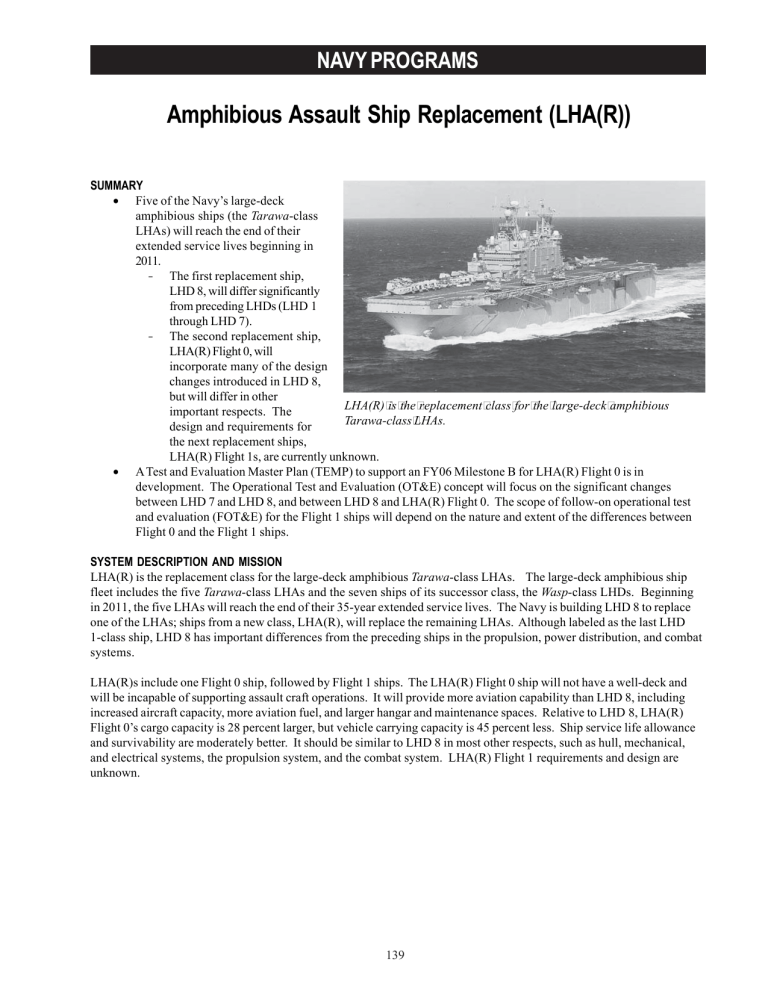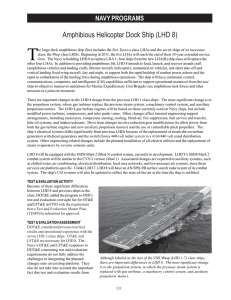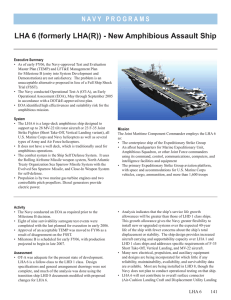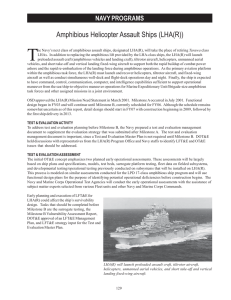Amphibious Assault Ship Replacement (LHA(R)) NAVY PROGRAMS

NAVY PROGRAMS
Amphibious Assault Ship Replacement (LHA(R))
SUMMARY
• Five of the Navy’s large-deck amphibious ships (the Tarawa -class
LHAs) will reach the end of their extended service lives beginning in
2011.
-
The first replacement ship,
LHD 8, will differ significantly from preceding LHDs (LHD 1 through LHD 7).
-
The second replacement ship,
LHA(R) Flight 0, will incorporate many of the design changes introduced in LHD 8, but will differ in other important respects. The design and requirements for
LHA(R) is the replacement class for the large-deck amphibious
Tarawa-class LHAs.
the next replacement ships,
LHA(R) Flight 1s, are currently unknown.
• A Test and Evaluation Master Plan (TEMP) to support an FY06 Milestone B for LHA(R) Flight 0 is in development. The Operational Test and Evaluation (OT&E) concept will focus on the significant changes between LHD 7 and LHD 8, and between LHD 8 and LHA(R) Flight 0. The scope of follow-on operational test and evaluation (FOT&E) for the Flight 1 ships will depend on the nature and extent of the differences between
Flight 0 and the Flight 1 ships.
SYSTEM DESCRIPTION AND MISSION
LHA(R) is the replacement class for the large-deck amphibious Tarawa -class LHAs. The large-deck amphibious ship fleet includes the five Tarawa -class LHAs and the seven ships of its successor class, the Wasp -class LHDs. Beginning in 2011, the five LHAs will reach the end of their 35-year extended service lives. The Navy is building LHD 8 to replace one of the LHAs; ships from a new class, LHA(R), will replace the remaining LHAs. Although labeled as the last LHD
1-class ship, LHD 8 has important differences from the preceding ships in the propulsion, power distribution, and combat systems.
LHA(R)s include one Flight 0 ship, followed by Flight 1 ships. The LHA(R) Flight 0 ship will not have a well-deck and will be incapable of supporting assault craft operations. It will provide more aviation capability than LHD 8, including increased aircraft capacity, more aviation fuel, and larger hangar and maintenance spaces. Relative to LHD 8, LHA(R)
Flight 0’s cargo capacity is 28 percent larger, but vehicle carrying capacity is 45 percent less. Ship service life allowance and survivability are moderately better. It should be similar to LHD 8 in most other respects, such as hull, mechanical, and electrical systems, the propulsion system, and the combat system. LHA(R) Flight 1 requirements and design are unknown.
139
TEST AND EVALUATION ACTIVITY
NAVY PROGRAMS
The TEMP required at the Flight 0 Milestone B will define an OT&E concept that starts with LHD 8 and addresses both
LHA(R) Flight 0 and Flight 1. DOT&E met with representatives from the LHD 8/LHA(R) program office and Navy staffs to identify OT&E issues as well as the requisite OT&E phases.
Live Fire Test and Evaluation included vulnerability tests using asymmetric attacks on a decommissioned ship. Also included were fire fighting and damage control tests on Navy’s fire safety research and test facility ship. The next test series of three vulnerability shots use a second decommissioned ship in FY05. Data from these tests will improve modeling fidelity of weapons effects propagation, especially in ships with large span decks like the LHA(R). Other surrogate testing planned in early FY05 at the Aberdeen, Maryland, Live Fire Test Facility will evaluate vulnerabilities from carried weapons and evaluate the bottom structure of the LHA(R).
TEST AND EVALUATION ASSESSMENT
Due to design similarities, LHD 8 test and evaluation results will apply to the LHA(R) Flight 0 evaluation; therefore, the
Flight 0 OT&E program needs LHD 8’s test and evaluation data to reduce the scope and expense of its OT&E. LHD 8 test and evaluation should be the first phase of Flight 0 test and evaluation. Adequate OT&E is required, but DOT&E will work with the Navy to identify ways to reduce unplanned cost and schedule impacts. For example, LHD 8 OT&E should leverage off of programmed ship tests/trials and training events as well as SSDS Mark 2 (Mod 3) OT&E. Similarly, the Navy has agreed to combine the LHD 8 survivability testing and evaluation into the LHA(R) program. Since the
LHA(R) design does not contain a well deck, for example, much of the fire fighting and damage control test data already conducted for the LHA(R) will now apply to the LHD 8.
For the Flight 0 ship, the OT&E concept emphasizes early operational assessments and the information that they provide. This process, modeled on similar assessments conducted for the LPD 17-class amphibious ship program, will use Preliminary/Contract Design plans to identify operational deficiencies before construction begins. The Navy and
Marine Corps operational test agencies will conduct the early operational assessments with the assistance of subject matter experts from various Fleet units and other Navy and Marine Corps Commands.
The scope of OT&E for Flight 1 ships will depend on any changes in ship mission, design, and requirements.
Consequently, the program manager, with assistance of the test and evaluation integrated process team, will update the
TEMP prior to the LHA(R) Flight 1 Milestone B.
140






